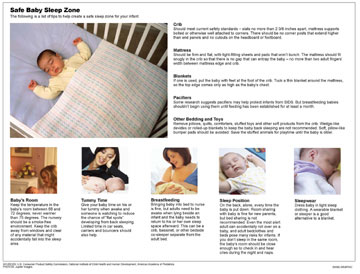 By LEE BOWMAN Scripps Howard News Service May 08, 2008
"I'm sure as the new mother of preemie African-American twins, I got some warnings about safe sleep and sudden infant death, but I was certain that would never happen to me,'' Glover said after taking part in a pre-Mother's Day briefing on infant survival strategies Monday on Capitol Hill.
"But I really don't remember anyone spelling out to me that my boys were at increased risk for SIDS." And in fact, Gordon and Garrett Glover had been thriving in their first three months, doubling their weight by that morning in early May 2000 when she woke to Gordon's soft cry and found his brother limp and unresponsive in the crib beside him. Glover, of Stone Mountain, Ga., had been a community health educator focused on diabetes care for some years before Garrett died. "As I grieved for him and met other parents who had lost children this way, I felt a calling to speak out about the ways people can reduce the risk for their babies,'' she told the gathering of aides sponsored by the Congressional Black Caucus and the infant survival advocacy group First Candle. African-American babies are at twice the risk of sudden unexplained infant death than white babies, and are more likely to be placed in an unsafe sleep position or setting, said Dr. Fern Hauck, a pediatrician and researcher into sleep safety at the University of Virginia. "Many black babies are still (tummy) sleeping and surveys show that bed sharing is also more prevalent among black moms,'' Hauck said. Hauck said given the jumbled national system of diagnosing and tracking infant deaths with no obvious medical cause -- documented in a Scripps Howard News Service series last year -- it's still unclear to what extent genetics, subtle physical traits and environmental factors are responsible for nearly 5,000 babies lost each year. But many organizations, including First Candle, are convinced that if all parents and caregivers would embrace safe sleep rules -- having babies sleep alone, on their back and in a crib -- the number of unexplained infant deaths could be cut by at least half. "If we could get out the word that a baby is 40 times more likely to die sharing a bed than sleeping alone, I don't think anyone would do it,'' said Marian Sokol, president of First Candle. In Georgia, Glover and a host of other advocates are still battling an epidemic of infant deaths. Out of 144 sudden infant deaths investigated by the state's Child Fatality Review Panel for 2005, only 30 were sleeping in a crib and more than half were sleeping in an adult bed. Glover spends much of her time doing safe sleep training for childcare providers. About 15 to 20 percent of sudden infant deaths occur with a babysitter. While Georgia is among the 49 states that now have a regulation or law on safe sleep positioning for child care, "there's a lot of turnover in this field and, just as with new parents, new people who need to get the messages,'' she said. Although pediatricians are officially encouraged to talk about safe sleep practices with parents, research by Hauck and others suggests the topic isn't addressed at many well-baby visits. With two thirds of American babies in child care at some point of their first year, "Parents are often more apt to take their cues from child care providers about where and how the baby's put down to sleep than from advice from health care workers,'' Glover said. Other caregivers -- such as grandparents -- can be more difficult to sway. "They say `Well, I slept with her and she did fine, she slept on her stomach and did fine.' But I find if we show them the research, explain how some of the risk factors are discovered, most of them get it," she said.
On the Web:
Distributed to subscribers for publication by Scripps Howard News Service, http://www.scrippsnews.com Publish A Letter in SitNews Read Letters/Opinions
|
|||
